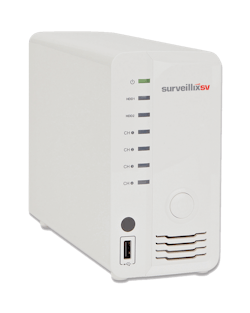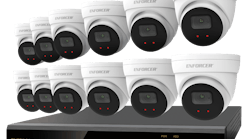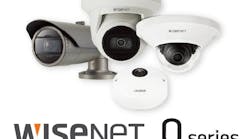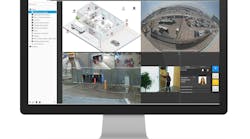Over the years, technological innovations have made video surveillance easier to install, operate and more customizable for both residential and commercial applications.
Practical video surveillance recording began as a Video Cassette Recorder (VCR), a multiplexer and analog video camera that could record streams of video up to three hours at 25-30 frames per second onto videotape. Prior to that, each video surveillance camera required its own VCR. The introduction of the multiplexer enabled a VCR to record several cameras' output (streams) onto the same videotape. The analog video has minimal resolution that was not compressed. The quality of the imagery was limited.
Next, the video capture card, faster processors and compression technology brought the introduction of the standalone Digital Video Recorder (DVR). Video compression enables higher number pixel images to be captured, while providing quality output at a substantially smaller size without significantly affecting the image quality of the video. Faster processors improve the speed from capture to record.
The video capture card replaced the multiplexer, converting the feed from the analog cameras to digital in order for the DVR to record. The video capture card is built into the standalone DVR.
The term "Digital" in DVR refers to the compression and storage technology only. The video images transmitted from the cameras to the DVR are analog. This limits the amount of data, which determines the resolution and the frames per second (FPS) that can be transferred from the camera to the DVR. The DVR video streams are digitized then recorded onto a storage system, which can include a disk drive, flash drive, memory card or RAID device, providing individual, discrete, viewable streams.
An important improvement of the DVR is non-linear access to recorded material. Recorded streams can usually be viewed by camera ID, time and date. With a VCR, you had only linear access, meaning you had to manually advance or reverse the tape in order to find a specific event.
For the DVR, different analog video formats include D1, which is the standard for American televisions, and conventional DVD video. D1 resolution is approximately 320,000 pixels, which is about 1/3 Megapixel. The D1 analog feed usually does not provide high enough resolution output to be able to identify a specific object, such as zooming in on a person's face, license plate or work area from a distance.
Analog surveillance video cameras transmit their signals via coaxial cables connected to the DVR. They are connected using Bayonet-Neil-Concelman (BNC) connectors. BNC connectors are miniature quick connect/disconnect connectors used for coaxial cable.
A DVR video surveillance system is comprised of a digital video recorder, cameras and a monitor to view video. The cameras capture the video and transmit to the DVR. At the DVR, the video is digitized and recorded. It can be monitored "live" or can be viewed at any time.
For example, a four-channel DVR has playback and the ability to record, show live previews, remote previews and back-up footage with up to four cameras. Digital Video Recorders are capable of operating as a Closed Circuit Television (CCTV) system.
DVR systems are available for four, eight, 16 or more cameras. Number of surveillance cameras is determined by the DVR model. Each DVR manufacturer offers specific features and functionalities into the standalone units. DVR features can include:
- 24/7 continuous recording, scheduled dates and hours, and motion detection and switch activation recording
- Varying recording resolutions including D1/4CIF (704 by 480)
- Video compression can include H.264
- Recording time dependent upon internal and external storage
- USB, Flash drive and/or DVD/RW Backup
- Pan, Tilt and Zoom camera controls
- Multiple motion detection zones with multiple sensitivity settings
- Alarm inputs
- BNC, VGA and HDMI video output
- RJ-45 Ethernet Port
The embedded (standalone) NVR (Network Video Recorder) is the latest surveillance video recorder hardware designed to operate with IP (Internet Protocol) cameras whose output is significantly greater than analog cameras. In addition, networked NVR and cameras are able to pass significantly greater amounts of data much faster than analog cameras connected to a DVR. Unlike the DVR that requires direct connection from recorder to camera, NVR equipment can be positioned almost anywhere within the network.
An NVR surveillance system is configured onto an Ethernet ready interface (network), with the cameras, switches and NVR interconnected using CAT5 and higher performance cables. This can be a significant savings as a portion of the wiring is probably already installed in most commercial facilities. When operating an NVR video surveillance system, the IP cameras encode and process the video, then stream it to the NVR for viewing and storage.
IP cameras capture video images at resolutions higher than analog. For example, a 720P IP camera that generates 1280 x 800 effective pixels produces more than 1 megapixel images, which are significantly greater than an analog D1 camera. Cameras are being introduced with two, three, five and higher effective pixel counts. The higher a camera's resolution, the better quality images it captures. As a result, finer details can be enlarged from greater distances, such as license plates, financial transactions and even facial recognition.
In addition to basic functionality that is a significant improvement over the conventional DVR, embedded NVRs can be easily integrated with alarm and access control systems. Being connected to the Internet enables the NVR surveillance system to provide live video to Android, iOS and Blackberry telephones and tablets in order to monitor activity.
Some NVR manufacturers offer portable, standalone NVRs for use in buses, service vehicles and mobile sales facilities. For example, the City of Los Angeles not only has cameras monitoring the interiors of their fleet of buses, but also has cameras mounted to monitor bus routes.
Since the introduction of the NVR, some manufacturers have developed the "hybrids" based on their DVRs. A video recorder sometime called a hybrid DVR or an HVR incorporate functions of both the DVR and the NVR. As time goes on, the new NVR technology is being introduced.
A partial list of DVR and NVR manufacturers include Bosch, Honeywell, LG, Lilin, Panasonic, Pelco, Samsung, Sony and Toshiba.
Editor’s Note: The first two installments of our video surveillance series covered the basics of an NVR video surveillance system. Read them at www.locksmithledger.com/11076301 and www.locksmithledger.com/11268401. This installment addresses the development of video surveillance recording hardware, beginning with the Video Cassette Recorder, onto the development of the Digital Video Recorder and the Network Video Recorder. In our next installment in this Video Surveillance series, we will discuss cameras.
To read additional Locksmith Ledger articles on video surveillance, visit http://tinyurl.com/video314.





